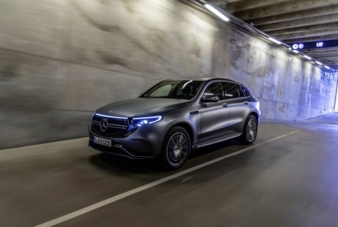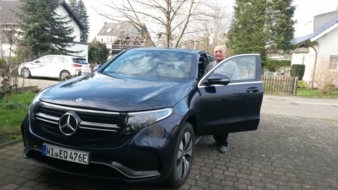22/02/2021 – Pure pleasure — auf Deutsch lesen
textile network reader service: The EQC 4Matic by Mercedes
Yvonne Heinen tested for textile network a number of electric cars in the power category as part of the research into the upcoming change in mobility.
In typical Mercedes fashion, the compact all-electric luxury SUV combines virtues such as impressive power reserves (300 kW/408 hp), cruising comfort and holistic intelligence that make life easier for drivers – from optimized navigation to charging management. Intelligent networking of services and functions considerably simplifies use of the vehicle. In the course of our journeys totalling 1,300 km/800 miles route with the EQC built at the Mercedes plant in Bremen, standard acoustic glazing ensures quiet while traveling. No tire rolling noise or wind noise disturbs the mobile meeting – impressive in comparison, even in the interior of an electric car: Four-wheel drive ensures superior control via traction even in the fast curves of the German B500 from Baden Baden to Freudenstadt, the “Black Forest High Road” popular with motorcyclists. However, the smart and silent SUV is not a sports car, nor should it be.
textile network as part of its research into the upcoming change in mobility, had the opportunity to test a number of electric cars in the power category on short and long journeys under real-life conditions suitable for everyday use.
Driving experiences that we will be sharing with you with this and later reports.
Due to the space required by the battery and 2 asynchronous electric motors, the e-Daimler with a trunk volume of just over 500 liters comes in at the rear of its class. Speaking of range, the EQC’s 80-kWh battery pack provides a respectable range of in average 252 miles (405 km) to us over a period of ten days along a mix of motorways, country roads and city driving in winter temperatures, which inevitably eat away from the battery charge. At times we are using recuperation to the hilt and yet also enjoying the downright driving pleasure that the power package laced from.
Even more relevant:
With an over period measured power consumption of 20.8 kWh/100 km the very first fully-electric car Daimler had launched is among the best in its class.
With some luck identifying rapid DC charging, the EV (electric vehicle) recharging from 30 to 90 percent is done in 30 minutes – and off we are. (Re-juicing to same level via a wall box or public AC charging took us 4 hrs and 30 minutes.)
Satisfied by reason, we experience a top speed of 112 mph (180 km/h) and pleasantly surprised climb – according to OEM specification – from 0 to 62 mph (100 km/h) in respectable 5.1 seconds.
Obviously for the price category, the features show futuristic aesthetics that place it firmly in the 21st century.
Optimal planning – safe piloting
We plan our routes from the home office for destination, enter departure time and bring the interior to the desired temperature from smart phone. Receiving an intelligently planned route including necessary charging stops and an arrival time – we are ready and best prepared to go… In terms of driving assistance systems, the star-powered Stromer scores with first-class interaction. The three driving modes, “Eco”, “Comfort” and “Sport”, differ significantly. Of course, we enjoy the dynamic driving program the most, but the EQC is much more restrained in Eco. Still temperamental enough for the city and good for the range.
Keyword: range anxiety
If the batteries are slowly running out of juice, the “Max Range” driving mode is the solution. Together with the navigation system, the system calculates the optimal route to the next charging station based on the course of the route, the traffic flow, and haptically helps the author to reach it, as a clear pressure point in the gas pedal marks how fast she can drive to be on the safe side. Setting the recuperation strength for deceleration by paddling behind the steering wheel (stronger on the left, weaker on the right) quickly becomes second nature to me. If I select the strongest level, I get by with the accelerator pedal (one pedal). The EQC also masters fuel-saving coasting – letting the car coast and thus making optimum use of the residual drive without consuming any more energy.
Cyclists are also much safer in the vicinity of the Mercedes EQC. The system detects cyclists in the blind spot – for example when turning right – and warns drivers. When the eight-year-old jumps out of his dad’s car and unexpectedly hits the rear bumper, the driving assistance system performs a 1A emergency braking action.
Yvonne Heinen-Foudeh





